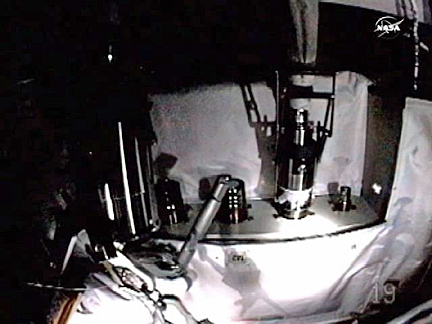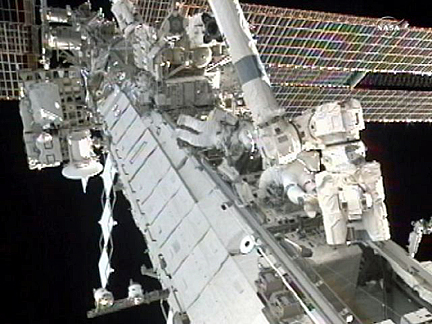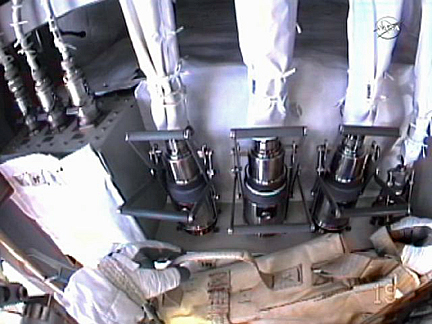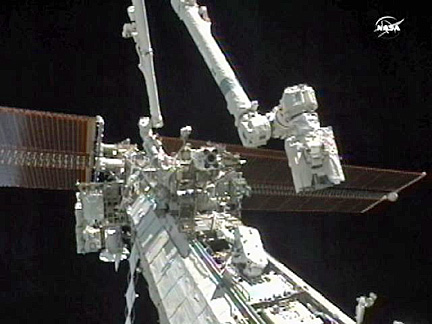Realtime Coverage of U.S. EVA-15
3:55 p.m. EDT Update: Spacewalk ends; troubleshooting continues
Astronauts Douglas Wheelock and Tracy Caldwell Dyson completed an eight-hour three-minute spacewalk today after a lengthy decontamination procedure to make sure any trace amounts of ammonia from a coolant system leak "baked out" before they re-entered the International Space Station.
The marathon spacewalk began at 7:19 a.m. EDT and ended at 3:22 p.m. when airlock repressurization resumed after decontamination. It was the longest station-based spacewalk by an expedition crew, although still shy of the U.S. EVA record of eight hours and 56 minutes.
Space station EVA time now stands at 929 hours and 38 minutes, or 38.7 days, over 148 spacewalks since assembly began in 1998. This was the first spacewalk for Caldwell Dyson and the fourth for Wheelock, who has now logged 28 hours and 44 minutes of EVA time.
2:05 p.m. EDT Update: Astronauts demate three coolant lines and free jammed fourth connector; but unexpected ammonia leak delays repair work
Douglas Wheelock and Tracy Caldwell Dyson, after successfully disconnecting a small cooling line and two larger ammonia lines from a faulty coolant system pump on the International Space Station, finally freed a jammed quick-disconnect fitting to release after lightly hammering on the mechanism.
"There's a big round of applause down here," Oscar Koehler radioed from mission control.
"Did you get it Wheels?" Caldwell Dyson asked.
"Yea, got it," Wheelock replied.
But as with the initial, unsuccessful attempt to free the M3 ammonia line, the astronauts reported an obvious, unexpected ammonia leak. Television views showed a shower of small ammonia ice crystals forming on the QD fitting and then snapping off and flying away into space.
 White ammonia ice crystals can be seen forming around the M3
White ammonia ice crystals can be seen forming around the M3quick-disconnect fitting. (Photo: NASA TV)
Wheelock was told to hold off pulling the ammonia line free while flight controllers assessed internal pressures to make sure there would not be a large leak when the line was detached.
"It's coming out pretty good now, Oscar," Wheelock reported 15 minutes after opening the latch.
After considering their options, flight controllers told Wheelock to reinstall a QD attachment designed to ensure an internal valve is fully closed and seated. He did that and initially reported, "I don't see anything else coming out."
But flight controllers decided to leave the M3 line in place, with an internal valve open, while they considered what might be causing the observed leakage. Wheelock and Caldwell Dyson were told to head back to the Quest airlock for spacesuit decontamination after installing insulation on the pump module fittings.
The primary goals of today's spacewalk were to detach four coolant system lines leading to the pump, along with five electrical cables. After that, the astronauts planned to unbolt the pump module and move it to a nearby storage location. Then, they hoped to retrieve a spare pump and bolt it in place on the S1 truss. Under that scenario, the ammonia lines would be reconnected during a second spacewalk Wednesday.
But the trouble disconnecting M3 threw a wrench into those plans.
The first cooling system line, M4, was removed with no problem and no leakage. The astronauts then turned to M3. After initially getting the latch open, the astronauts reported a small ammonia leak. The latch was closed in a bid to tightly seal the leak, but it refused to budge in subsequent attempts to get it back open.
While flight controllers discussed options, the astronauts turned to M2 and then M1. Both of those fittings disconnected with no problems and no significant ammonia leakage.
"Don't you wish they were all that easy?" Koehler asked.
"Yeah," Wheelock laughed. "I wish M3 would act like its neighbors."
With time running out for today's spacewalk, Koehler told Wheelock to go back to M3 and make one more try to get its quick-disconnect mechanism to release. With a jumper box installed to help maintain the proper pressure in the coolant lines, pressure in the line was slightly lower, raising hopes the QD mechanism would release.
But once again, Wheelock was unable to move the latch. He then was cleared to lightly hammer on a release button in hopes of freeing the jam. The brute force approach worked, and at 12:20 p.m. Wheelock rotated the release latch open. But the unexpected ammonia leak forced flight controllers to leave the line in place while troubleshooting continues.
Because of the ammonia leak, Wheelock and Dyson will have to spend extra time in the Quest airlock, allowing any residual ammonia that might be on their spacesuits to "bake out," before they can re-enter the station. Because of that, flight controllers decided to end today's spacewalk after the astronauts installed insulation on the disconnected lines.
With all four coolant lines disconnected and with the jumper box in place, the coolant loop was in a safe configuration. Removal of the failed pump and installation of its replacement will be deferred to a second spacewalk Wednesday.
12:55 p.m. EDT Update: Jumper box installed
After running into problems disconnecting the stubborn M3 ammonia line from a faulty coolant pump, spacewalker Douglas Wheelock was told to put that task on hold and to proceed instead to disconnecting the M2 coolant line adjacent to M3. This time around, the quick-disconnect fitting released with no major problems and with no signs of any ammonia leakage.
It is not yet clear how the problem with the M3 connector might be resolved. Wheelock had problems initially releasing the fitting and then, because of a small ammonia leak, he was asked to cycle the latch closed and back open again. He was able to close the latch, but the mechanism refused to budge when he attempt to re-open it, presumably because of high internal pressure.
Flight controllers then asked him to wait for orbital darkness before making another attempt in hopes that lower temperatures would reduce the pressure. But again, he was unsuccessful. After considering their options, and with the spacewalk running well behind schedule, flight controllers told Wheelock to proceed with the M2 quick-disconnect fitting.
With the M2 line free of the loop A coolant pump, Wheelock connected it to a jumper box designed to help maintain the proper pressure in the ammonia system while the pump is being replaced. He then connected the smaller M4 cooling line, which was demated earlier. The jumper box may help resolve the problem with the M3 connector, but that remains to be seen.
Along with M3, the M1 QD fitting must be released before the crew turns its attention to electrical connections. After that, if time is available, the faulty pump can be unbolted and moved to a nearby stowage location. But first, all of the ammonia lines must be demated.
11:50 a.m. EDT Update: Ammonia line disconnections begin; astronauts run into problems with second fitting
Four hours into today's spacewalk, astronaut Douglas Wheelock, after venting nitrogen used to pressurize coolant lines leading to a faulty pump module, has started demating ammonia line quick-disconnect fittings. The first quick-disconnect fitting, known as M4, closed easily and no ammonia leakage was observed. But he ran into problems with the second line, M3, which required more force to open. Using a lever tool, however, Wheelock got the second line unlatched, but a small amount of ammonia could be seen escaping.
"I see little sparklets of ammonia coming from the line," Wheelock reported.
"I copy. Are they continuous, or did you just see a few at first?" asked Oscar Koehler in mission control at the Johnson Space Center in Houston.
"It's just sort of random, like little tiny snowflakes," Wheelock said.
He was then asked to cycle the quick-disconnect latch, fully re-mating the connector with its internal valve open. More ammonia escaped as he moved the latch. He then ran into more problems trying to open the latch back up, presumably because of internal pressure.
After multiple attempts with the lever tool, he muttered "wow, that thing is not budging, Oscar." Astronaut Shannon Walker, operating the station's robot arm, moved Wheelock into a more favorable position and he tried again. But again, he was unable to re-open the latch. Koehler told him to take a break at that point and to wait for orbital darkness in hopes that the temperature change would reduce the internal pressure and make the latch easier to throw.
The M3 and M4 lines must be connected to a jumper box that will allow ammonia in the loop A coolant system lines to expand and contract as needed while the pump is replaced.
 Flight controllers and astronauts at the Johnson Space Center in Houston
Flight controllers and astronauts at the Johnson Space Center in Houstondiscuss options for freeing up the M3 quick-disconnect fitting. (Photo: NASA TV)
After demating all four ammonia line quick-disconnect fittings, the astronauts will disconnect five electrical cables. At that point, the spacewalkers will begin unbolting the pump module from the S1 truss so it can be removed. But first, the astronauts must resolve the problem with the M3 quick-disconnect fitting.
Wheelock and Caldwell Dyson well behind schedule at this point. Because of the observed ammonia, both spacewalkers will have to undergo a spacesuit decontamination "bake out" procedure at the end of the spacewalk. It is not yet clear if they will have time to install the new pump during today's spacewalk even if the old pump can be disconnected and moved out of the way.
10:00 a.m. EDT Update: Wheelock gets on station robot arm; pump module replacement work begins in earnest
Astronaut Douglas Wheelock has now anchored himself on the end of the space station's robot arm where he will remain for most of today's spacewalk. Astronaut Shannon Walker, operating the arm from inside the Destiny laboratory module, will position Wheelock as required for the ammonia line/electrical cable disconnections needed before a faulty pump module can be removed. Tracy Caldwell Dyson will be working from a portable foot restraint mounted on the S1 truss near the pump.
Taking over a task from Caldwell Dyson, Wheelock planned to install a vent tool on ammonia quick-disconnect fitting M3 in preparation for connecting a so-called jumper box needed to maintain the proper pressure in the coolant system during the pump changeout.
 Wheelock, anchored to the station's robot arm, and Caldwell Dyson prepare to
Wheelock, anchored to the station's robot arm, and Caldwell Dyson prepare todisconnect failed pump module. (Photo: NASA TV)
 The view from Wheelock's helmet cam showing four ammonia line quick-disconnect
The view from Wheelock's helmet cam showing four ammonia line quick-disconnectfittings. (Photo: NASA TV)
 Astronaut Douglas Wheelock, working on the S1 truss segment at the loop A
Astronaut Douglas Wheelock, working on the S1 truss segment at the loop A